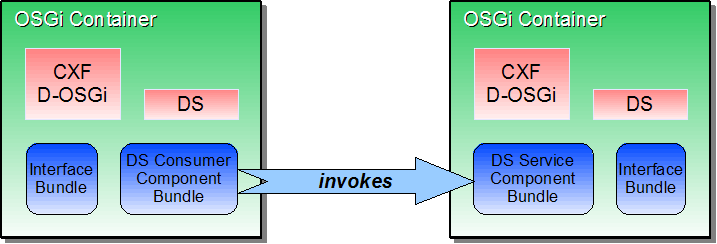|
This page describes the CXF Distributed OSGi with Declarative Services demo. The Declarative Services demo uses a DS implementation to create a remoted OSGi service from a DS component. The consumer side uses DS to create a component that consumes the remote OSGi service. By using Declarative Services, you don't need to write code to interact with the OSGi Service Registry. That's all handled through injection which hugely simpliefies the code. This demo can be used with any DOSGi distribution, in this document the single-bundle distribution is used with the Equinox implementation of DS. Demo designThis demo is quite similar to the Spring-DM demo and the Greeter demo in structure. It consists of 3 bundles:
The service implementation and consumer bundle are built using DS. public interface AdderService {
int add(int a, int b);
}
The Adder Service ImplementationThe service implementation providers a simplistic implementation of the AdderService interface, which is instantiated as a DS component. In the <scr:component xmlns:scr="http://www.osgi.org/xmlns/scr/v1.1.0" name="DS Service Sample">
<implementation class="org.apache.cxf.dosgi.samples.ds.impl.AdderServiceImpl"/>
<property name="service.exported.interfaces" value="*" />
<property name="service.exported.configs" value="org.apache.cxf.ws" />
<property name="org.apache.cxf.ws.address" value="http://localhost:9090/adder" />
<service>
<provide interface="org.apache.cxf.dosgi.samples.ds.AdderService"/>
</service>
</scr:component>
Note that the Service-Component: OSGI-INF/component.xml So let's install the server side in Equinox, together with the Equinox DS implementation. You can do this from the Equinox command line, but in this document I'll launch Equinox from within Eclipse (last tried with Eclipse 3.6).
Now run the OSGi container, you will get a setup like this: osgi> ss Framework is launched. id State Bundle 0 ACTIVE org.eclipse.osgi_3.5.0.v20090520 1 ACTIVE org.eclipse.equinox.util_1.0.100.v20090520-1800 2 ACTIVE org.eclipse.osgi.services_3.2.0.v20090520-1800 3 ACTIVE cxf-dosgi-ri-singlebundle-distribution 4 ACTIVE org.eclipse.equinox.ds_1.1.0.v20090520-1800 Now I can install the DOSGi DS bundles in the OSGi container directly from the maven repository. osgi> install http://repo1.maven.org/maven2/org/apache/cxf/dosgi/samples/cxf-dosgi-ri-samples-ds-interface/1.2/cxf-dosgi-ri-samples-ds-interface-1.2.jar Bundle id is 5 osgi> install http://repo1.maven.org/maven2/org/apache/cxf/dosgi/samples/cxf-dosgi-ri-samples-ds-impl/1.2/cxf-dosgi-ri-samples-ds-impl-1.2.jar Bundle id is 6 osgi> start 6 ... log messages may appear ... You can also import the maven projects of the DS demo into Eclipse, this would save you from installing it with a URL as above. To do this, check out the CXF/DOSGi source from SVN (http://svn.apache.org/repos/asf/cxf/dosgi/trunk), run At this point, the service should be available remotely, you can check this by obtaining the WSDL: The Adder Service ConsumerThe service consumer is also created using DS. DS creates an AdderConsumer component which is injected with a reference to the remote AdderService. Like in Spring, the injection is done by DS, which makes the code nice and simple. When the injection is done, the start() method is called. public class AdderConsumer {
private AdderService adder;
public void bindAdder(AdderService a) {
adder = a;
}
public void unbindAdder(AdderService a) {
adder = null;
}
public void start(ComponentContext cc) {
System.out.println("Using adder service: 1 + 1 = " + adder.add(1, 1));
}
}
The client side bundle contains an <scr:component xmlns:scr="http://www.osgi.org/xmlns/scr/v1.1.0" activate="start"> <implementation class="org.apache.cxf.dosgi.samples.ds.consumer.AdderConsumer"/> <reference interface="org.apache.cxf.dosgi.samples.ds.AdderService" name="AdderService" cardinality="1..1" policy="dynamic" bind="bindAdder" unbind="unbindAdder"/> </scr:component> As on the service provider side, the client side bundle needs to contain the DS header in the Service-Component: OSGI-INF/component.xml As in the Greeter demo, the client side needs to be configured to know where the remote service actually is. This is one in the <endpoint-descriptions xmlns="http://www.osgi.org/xmlns/rsa/v1.0.0">
<endpoint-description>
<property name="objectClass">
<array>
<value>org.apache.cxf.dosgi.samples.ds.AdderService</value>
</array>
</property>
<property name="endpoint.id">http://localhost:9090/adder</property>
<property name="service.imported.configs">org.apache.cxf.ws</property>
</endpoint-description>
</endpoint-descriptions>
Install and run the consumer side of the demo in a separate Equinox instance (tip: you can duplicate the launch configuration used for the server side in the 'Run Configurations' dialog): osgi> install http://repo1.maven.org/maven2/org/apache/cxf/dosgi/samples/cxf-dosgi-ri-samples-ds-interface/1.2/cxf-dosgi-ri-samples-ds-interface-1.2.jar Bundle id is 5 osgi> install http://repo1.maven.org/maven2/org/apache/cxf/dosgi/samples/cxf-dosgi-ri-samples-ds-client/1.2/cxf-dosgi-ri-samples-ds-client-1.2.jar Bundle id is 6 osgi> start 6 ... log messages may appear, after a little while the following message appears: Using adder service: 1 + 1 = 2 The remote adder service has now been invoked. You will see the following line on the server side Equinox window: Adder service invoked: 1 + 1 = 2 Consumer NoteSome OSGi Declarative Services implementations don't explicitly register interest in the requested services with the OSGi Framework. They rather user a generic Service Tracker or Service Listener to track all available services. This doesn't provide the CXF-DOSGi implementation with the information about what services the consumer is looking for through the ListenerHook and hence it can't register the remote service on-the-fly. A simple workaround to this problem is to add an Activator to a bundle in the client-side framework (this activator could be in any bundle) which registers an explicit ServiceTracker for the remote service the DS component wants to be injected with. An example of such an Activator can be found here. In the future a more elegant solution to this problem will hopefully be provided. |


